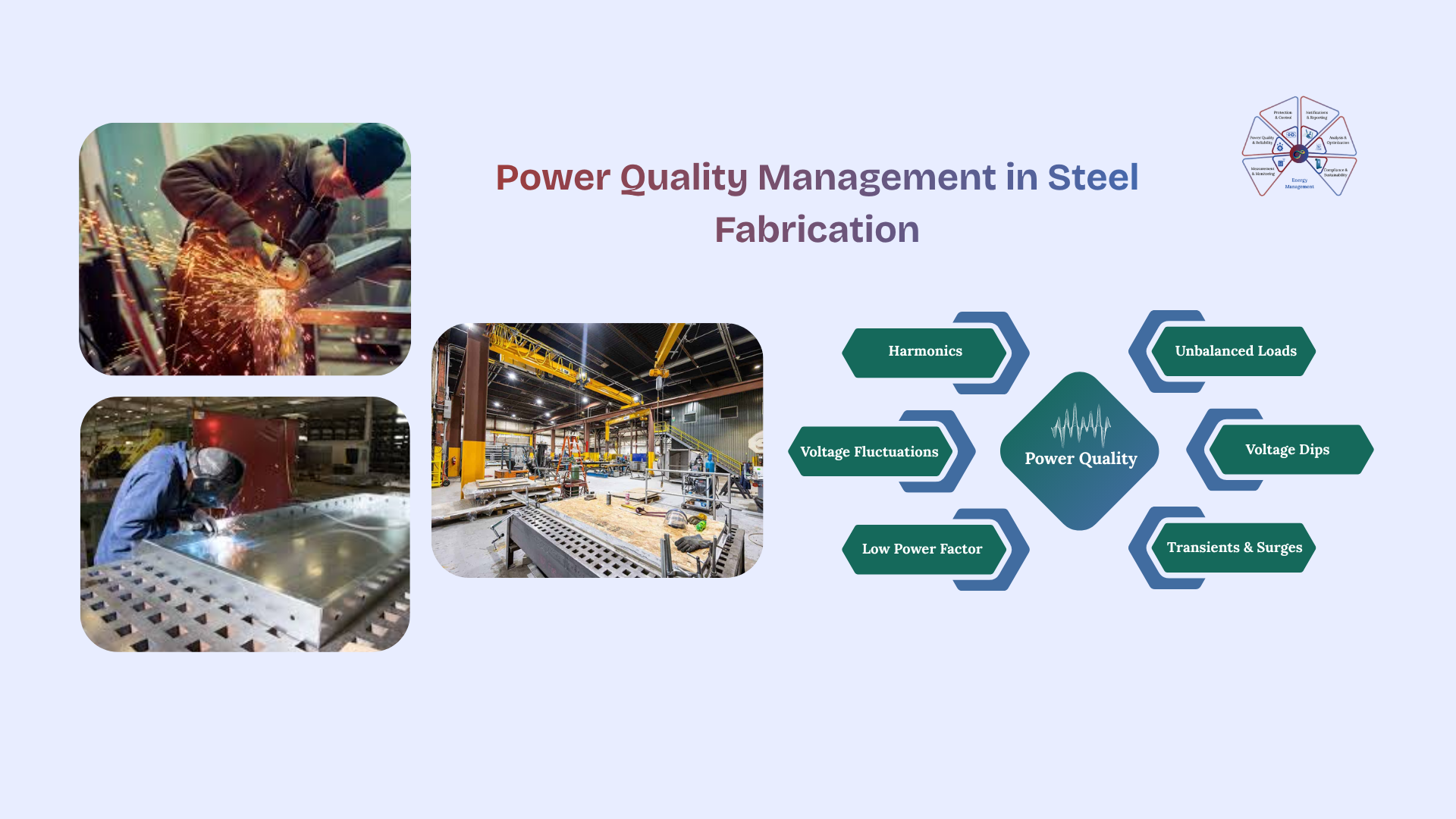Power Quality in Steel Fabrication: Hidden Losses That Hurt OEE and Reliability

In a steel fabrication unit near Hapur, the rhythmic hum of welding machines and the precise movements of CNC cutters define productivity. The plant runs multiple MIG/TIG welding sets, plasma cutters, CNC profile machines, hydraulic presses, rolling machines, and heavy-duty compressors — each demanding steady and reliable power to maintain production rhythm.
The Situation on Ground
The maintenance team had earned respect for their quick action whenever faults occurred — a tripped feeder, a machine shutdown, or a flickering welding torch. Yet, with time, the pattern of disturbances grew frequent and less predictable.
- Welders began noticing erratic arc behaviour.
- CNC machines occasionally froze mid-program.
- Compressors and chillers drew unusually high current during startup.
- Control relays were failing faster than expected.
Production teams started reporting delayed deliveries and inconsistent part quality. Energy costs rose, and yet, output didn’t.
During periodic review meetings, the plant head and maintenance manager jointly raised a critical question:
“We are fixing problems every day — but are we really solving them?”
That question changed the direction of discussion — from repairing to understanding.
Tracing the Invisible: Power Quality as a Root Cause
A joint team of electrical engineers and production supervisors began tracking disturbances across key electrical panels and feeders. Using handheld analyzers, they discovered repeating events:
- Voltage sags whenever multiple welding machines were triggered simultaneously.
- Harmonics distortion from variable frequency drives in hydraulic press motors.
- Fluctuating neutral currents affecting CNC controllers and PLC logic.
These issues weren’t severe enough to shut down power entirely — but they were eroding reliability from within, like silent corrosion.
Each minor disruption translated into:
- CNC reprogramming delays (≈10–15 min per event)
- Welding rework due to inconsistent arc stability
- Compressor thermal trips during voltage dips
- Increased downtime, affecting Overall Equipment Effectiveness (OEE)
When engineers mapped these small events across a month, they realized almost 6–8% production hours were lost — not to mechanical failures, but to power quality deviations.
Step One: Data-Driven Diagnosis
The maintenance team decided to install power quality analyzers and data loggers at key nodes — welding bay subpanels, CNC feeders, and the main LT incomer.
Over a two-week monitoring cycle, they observed:
| Parameter | Ideal Range | Actual Observations | Likely Impact |
|---|---|---|---|
| Voltage Unbalance | < 1% | 2.8–3.2% | Overheating of motors, reduced lifespan |
| THD (Total Harmonic Distortion) | < 5% | 8–12% | Controller malfunction, relay failures |
| Voltage Sag Frequency | — | 7–10 per shift | Arc instability, process interruption |
| Power Factor | > 0.95 | 0.88–0.91 | Excess demand charges, higher losses |
These numbers gave the team a clear visual correlation between electrical quality and production issues.
Step Two: Implementation — From Observation to Optimization
The team, in collaboration with Intelliware, began implementing a multi-level corrective plan:
- At Machine Level
- Installed individual line reactors and filters for CNC and VFD-driven equipment.
- Added surge suppressors on welding bays.
- At Distribution Level
- Introduced automatic power factor correction (APFC) with real-time kVAR compensation.
- Deployed harmonic filters to stabilize voltage and protect sensitive controllers.
- At Facility Level
- Implemented permanent power quality monitoring using Elmeasure PQ analyzers with cloud reporting.
- Created alerts for voltage dips, unbalance, and harmonic thresholds.
Step Three: Measurable Outcomes
Within two months, the improvements were tangible:
- Unplanned downtime reduced by 40%.
- Energy bills dropped by 8–10%, owing to power factor correction and lower harmonic losses.
- CNC and welding machine complaints dropped significantly.
- Equipment operating temperature stabilized, enhancing component life.
More importantly, maintenance became predictive — alerts highlighted deviations before they caused breakdowns. The plant finally transitioned from reactive firefighting to data-backed reliability management.
The Broader Perspective: Power Quality as a Productivity Lever
In high-energy industries like steel fabrication, the real efficiency challenge lies not only in machines but in the invisible behaviour of electrical energy.
Power quality deviations — voltage dips, unbalance, harmonics, transients — silently reduce the availability and performance components of OEE. Monitoring and managing them transforms maintenance into a strategic function that directly supports production and profitability.
Key Takeaways for Maintenance Managers
- Monitor critical feeders — not just the incomer. Each process cluster (welding, CNC, compressors) deserves independent observation.
- Correlate faults with power quality logs — it converts subjective “machine misbehaviour” into measurable data.
- Invest in PQ analytics before adding new machines — expansion amplifies existing electrical weaknesses.
- Plan upgrades, not overhauls — targeted filters, APFC, and structured monitoring can yield 80% results with 20% investment.
Lessons Learned
Power quality issues are often the last thing engineers check — and the first thing that affects everything else. For industries running complex electro-mechanical systems, managing energy quality is not a luxury; it’s a maintenance necessity.
The Hapur plant’s story underscores a fundamental truth: what you can’t see can still hurt your OEE.
If your plant relies on welding, CNC, or VFD-based machinery and you’ve observed unexplained faults or rising energy bills, it might be time to look deeper into your power quality landscape.
At Intelliware, we help industrial users in Delhi NCR and beyond implement practical and scalable power quality monitoring — using Elmeasure analyzers, automatic power factor correction systems, and harmonic mitigation solutions that fit your process, not just your panel.
📞 Let’s discuss your plant’s reliability roadmap.
Visit www.intelliware.in or reach out for a free preliminary assessment of your power quality profile.
- Call/SMS/WhatsApp: +91 8279921905
- email: contactus@intelliware.in
- Facebook: https://www.facebook.com/intelliware.in
- LinkedIn: https://linkedin.com/company/intelliware-in

